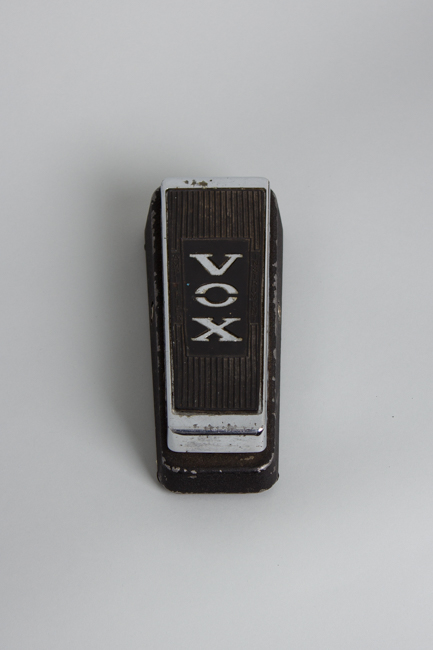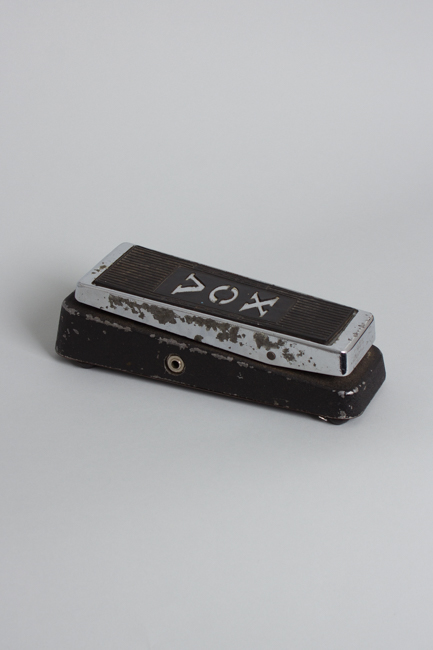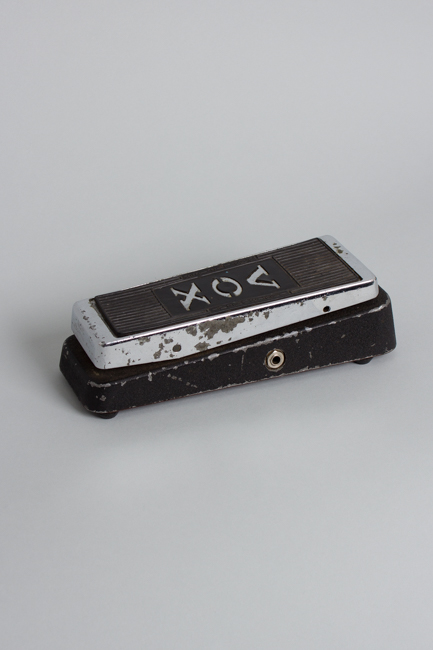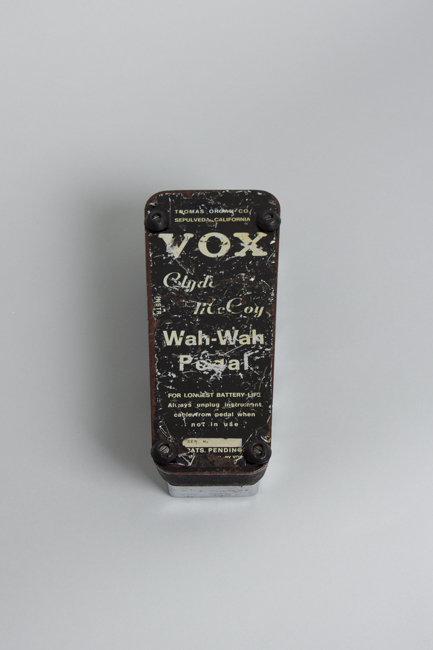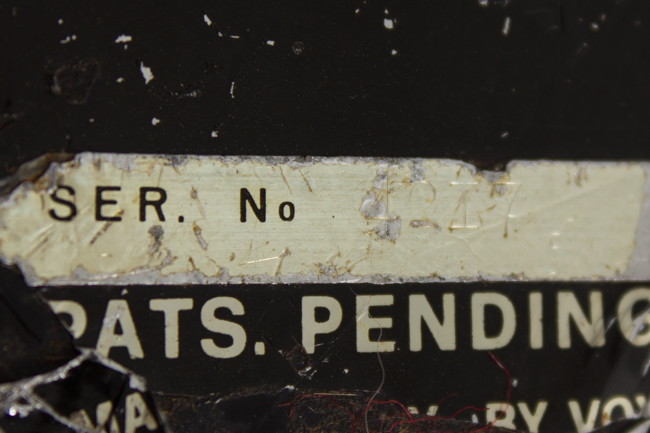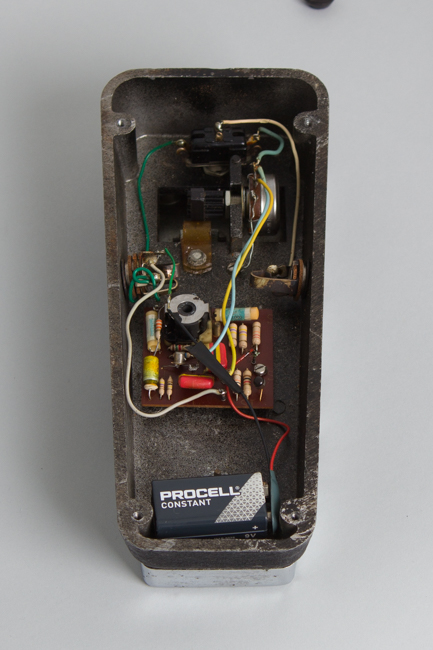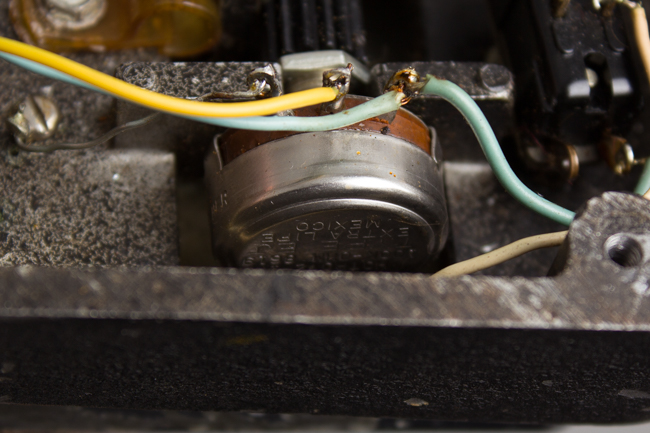Vox Clyde McCoy Wah-Wah Pedal Effect (1967)
Vox Clyde McCoy Model Wah-Wah Pedal Effect (1967), made in Sepulveda, California, serial # 4277, chrome and textured enamel finish.
As commercial production boomed in the early to mid 1960's, California's Thomas Organ Company was an American distributor for the Vox, a British company. After several years facing high costs for importing products and materials, Thomas Organ struck a deal to become a completely independent and autonomous seller and devleoper of new gear in America while staying under the Vox name. One of their earliest offerings was a guitar boosting module called the MRB, or Mid-Range Resonant Boost; it was found that when toggling between the three-way frequency switch, an unusual "wah" was produced. A young engineer named Brad Plunkett was tasked with redesigning the effect into a simpler and sweepable filter. Plunkett would come to develop what would undoubtedly cement themselves in the historical record of effect pedals: the Clyde McCoy Wah-Wah.
In 1966, Thomas Organ released the 'wah-wah' pedal, attributed to Clyde McCoy: not a guitarist, but a trumpet player! The pedal was intended to achieve a similar effect for guitar to the warbling effect of a muted trumpet. The pedal centers around a relatively simple circuit running off a 9V battery and halo inductor with the filter of the wah controlled by foot. The pedal went through a few changes, both cosmetically and in regards to production over the years. By 1967 when this example was made, the pedal would have been built in Italy with a 'Clyde McCoy' cursive script label on the back rather than the made-in-California portrait design of the first few pedals. The company would go on to release similar versions of the pedal under different monikers (famously the Crybaby_ as the sensation spread and competitors began creating their own renditions of Plunkett's wah. This one may have been dragged through battle it seems, but this is still "the real McCoy!"
Length is 10 in. (25.4 cm.), 4 in. (10.2 cm.) width, and 3 in. (7.6 cm.) high.
There is no denying that this McCoy has seen a fair amount of heavy stage and studio use with wear overall and corrosion in the chrome. The original stacked pot was replaced quite a while ago with a Dunlop Hot Potz potentiometer dated 1986; a fair bit of the wiring including the 9V adapter was seemingly replaced at the time of that service, and the circuit itself appears original down to the snazzy Mullard 'tropical fish' and Ducati capacitors and the halo inductor. The mechanics of the pedal are working smoothly and properly, and the original foam is quite dry but still in place and functional when the pedal is fully engaged; fresh additional foam can be added upon buyer's request. A player grade example of one of the all-time classic effect pedals. Overall Very Good Condition.
As commercial production boomed in the early to mid 1960's, California's Thomas Organ Company was an American distributor for the Vox, a British company. After several years facing high costs for importing products and materials, Thomas Organ struck a deal to become a completely independent and autonomous seller and devleoper of new gear in America while staying under the Vox name. One of their earliest offerings was a guitar boosting module called the MRB, or Mid-Range Resonant Boost; it was found that when toggling between the three-way frequency switch, an unusual "wah" was produced. A young engineer named Brad Plunkett was tasked with redesigning the effect into a simpler and sweepable filter. Plunkett would come to develop what would undoubtedly cement themselves in the historical record of effect pedals: the Clyde McCoy Wah-Wah.
In 1966, Thomas Organ released the 'wah-wah' pedal, attributed to Clyde McCoy: not a guitarist, but a trumpet player! The pedal was intended to achieve a similar effect for guitar to the warbling effect of a muted trumpet. The pedal centers around a relatively simple circuit running off a 9V battery and halo inductor with the filter of the wah controlled by foot. The pedal went through a few changes, both cosmetically and in regards to production over the years. By 1967 when this example was made, the pedal would have been built in Italy with a 'Clyde McCoy' cursive script label on the back rather than the made-in-California portrait design of the first few pedals. The company would go on to release similar versions of the pedal under different monikers (famously the Crybaby_ as the sensation spread and competitors began creating their own renditions of Plunkett's wah. This one may have been dragged through battle it seems, but this is still "the real McCoy!"
Length is 10 in. (25.4 cm.), 4 in. (10.2 cm.) width, and 3 in. (7.6 cm.) high.
There is no denying that this McCoy has seen a fair amount of heavy stage and studio use with wear overall and corrosion in the chrome. The original stacked pot was replaced quite a while ago with a Dunlop Hot Potz potentiometer dated 1986; a fair bit of the wiring including the 9V adapter was seemingly replaced at the time of that service, and the circuit itself appears original down to the snazzy Mullard 'tropical fish' and Ducati capacitors and the halo inductor. The mechanics of the pedal are working smoothly and properly, and the original foam is quite dry but still in place and functional when the pedal is fully engaged; fresh additional foam can be added upon buyer's request. A player grade example of one of the all-time classic effect pedals. Overall Very Good Condition.
